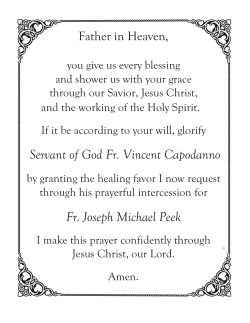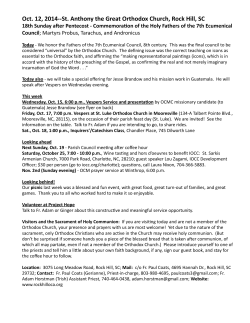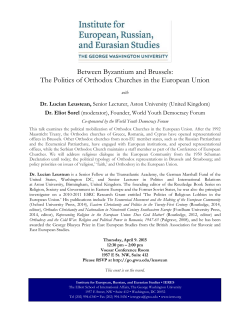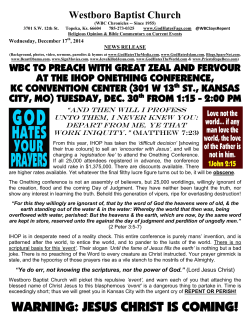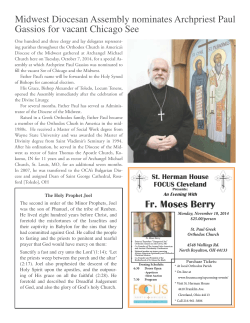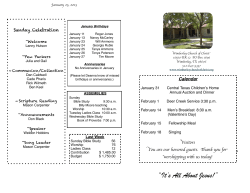
TOA March 2015 - WordPress.com
The Orthodox American March 2015 March Birthdays 3/9 Douglas Wright 3/10 Robert Aitchison 3/10 Andrew Vitale 3/11 Craig Dunn 3/21 Robert Zahrt 3/22 Michael Cabler 3/28 Michael Green The Orthodox American newsletter Bishop Douglas Wright I think I will use my space this issue to run by you the origins of our title. When Bishop James came to us from Lexington he brought it with him and Alfred, and George adopted it as being witty. Whereas George published long apologetics on our existence, the new Orthodox American was supposed to be filled with articles contributed by the clergy do we could get to know one another as well! Didn't seem to happen that way, as it is like pulling teeth to get articles from the clergy! I have always suspected it was because many of them were priests on paper only with neither a parish, nor an outreach of some sort. I chronicled the rise of our Damariscotta congregation which after several years of gathering I lost them overnight when Archbishop George said women would be ordained over his bleeding and dying body! Again I chronicled the rise and subsequent dispersal of my Whitefield Sunday school up to 14 at one time. Now I guess what I want to stress here is that we are not given to know on this life the true impact of our various ministries. No indeed! Every person we meet could be our Lord in disguise! Please don't forget that for a moment! Blessings to you all! A New England Winter in photographs Bishop Douglas Wright The Orthodox American March 2015 How easy is it to get caught up in the trappings? Father Scott Green I have been in the midst of controversy and wondering how I was supposed to handle the situation. The subject of the controversy is unimportant. The truth is, we each have our own troubles in this life, and how we deal with them is of vital importance. We search for answers and pray or curse or placate, struggling to discover the proper course of action. We look at our surroundings and cry out in our pain. Sometimes alone and other times with our loved ones. Then we attempt to come to an understanding of our dismay. "I'll take a logical look at this" we'll say to ourselves. All the while the answer is right in front of us. I find myself caught up in these trappings more often than I want to admit. I say to myself "you know better" but still manage to flail away like the human I am. But then a child comes along and reminds me of the truth. We are all Gods children. So, BE QUIET! LISTEN. More often than not my life is filled with the need for quick thought and rapid answers. But then I'm a nurse, so this is the norm. I have a bad habit of bringing that process home with me and trying to apply it to the rest of my life. Not the best idea. It's far to easy to lose oneself in the world. So I just wanted to remind you my friends of the real need to BE QUIET! and LISTEN. Listen to the children playing in a park. Listen to the birds or the sounds of nature. Listen to the sound of your better half breathing in their slumber. This is a good place to find peace and ultimately answers to the troubles in your life. For these are the songs of peace and Gods love Finding rejected cornerstones: Potential OCCA Clergy Bishop Douglas Corry Smith In the midst of confrontation from established ecclesiastical authorities, Jesus quotes the 118th Psalm: “The stone which the builders rejected has become the cornerstone.” In knowing many personal histories of our OCCA clergy, there is an often-repeated theme: established ecclesiastical authorities have for one reason or another, rejected us. Yet, I have seen in our OCCA ranks many whom I feel are truly doing the ministry of Christ in a more genuine way than the “authorities” that rejected them; many of our OCCA clergy are true “cornerstones” for the Church of Christ. Knowing this fact, in recent years I have recommended for ordination several persons that duplicate this OCCA phenomena. And I hope to find more in the future. In many ways I feel that this is our unique OCCA calling when it comes to finding new clergy for our community: finding those rejected cornerstones. When I was going to Virginia Theological Seminary, we were graded by two criteria: academically (how well we did in our courses) and politically (how closely we fit into the established norm of Episcopal clergy). I remember several seminarians that scored high academically but were asked to leave seminary for “political” reasons because of their lifestyles, their sexual orientation or their heart-felt philosophical convictions that did not “fit the established norm.” Every person I saw that was asked to leave for those “political” reasons was someone I saw as a person who better represented the Gospel of Christ than those who were of the established norm. The Orthodox American March 2015 In searching out future OCCA clergy, these are the types of people I am searching for: people who truly represent the Gospel of Christ, who have a firm academic background in hermeneutics/theology/liturgy and social ministry, who have also, for one reason or another, been rejected by the established ecclesiastical authorities. I have found that these are people with true “potential.” And, as I continue to travel in my work, I am searching out such people. Our world still has Sadducees and Pharisees – of the same breed as those who attacked Jesus. Let’s not add to our ranks with more of the same ilk as those Sadducees and Pharisees; but let us continue to expand by finding more “cornerstones.” The cornerstones will always be outnumbered by the other building blocks, but let’s seek out those cornerstones, especially those that have been rejected by the “normal” “established” builders. Talking story Mother Laura Emerson I am writing these thoughts on some of the spiritual experiences I have had since moving to Hawaii, after discussions with Metropolitan Peter at Synod. I moved to "paradise" in November of 2013. My husband and I had talked about moving to Hawaii, and I optimistically thought that we would both be alive to enjoy this experience together. He died while we still lived in California, and I was faced with a dilemma: as we will ultimately be buried together, where I bury him would be where I would live out the rest of my life. So, I buried him in "Valley of the Temples," a large cemetery on Oahu, in the mists of (and in the midst of) the sublime, mystical Ko'olau mountains. The sense of being close to heaven is palpably felt there. On the grounds is a reproduction of a 950 year-old Buddhist Temple, thus the cemetery name. I wanted to live on the leeward (western) side of the island, because it is drier there (much less rain). It is almost impossible to find a landlord willing to rent to me without having met me, and rarer still to find a landlord willing to accept my dog, and I had to be out of the house in three weeks. They took a chance on me (the first "miracle") and I rented the place sight unseen, after researching the realty company. I moved to the country--Makaha, the most northwest community on the island. Beautiful, rustcolored wild chickens roamed our yards and grazed for insects. I lived in the foothills of the Waianae Mountains, between the mountains and the ocean, a breathtaking coastline with large surfing waves. Despite its beauty, the main highway was the only way in and out, and if there was an accident, you couldn't get through. Shopping and obtaining services was difficult. Many companies refused to come out there, calling it "the wild west." For all of the riches of its natural beauty, residents of the leeward coast are crushingly poor. It is a very economically-disadvantaged area, with poverty, huge homeless encampments, no jobs, heavy drug use, and soaring crime rates. All of my neighbors had "Section 8" public housing assistance, and got their food from food banks. Poor nutrition and poor healthcare are the norm on this part of the island. I was saddened to hear that fully half of Hawaiians are diabetic, and that half of those remain undiagnosed. This part of the island is almost completely Native Hawaiian. I was the only white person in the neighborhood. The Orthodox American March 2015 My neighbors would not look at me, or acknowledge me in any way. They would not look at me, even though we lived no more than 20 feet apart. They looked "through me." It seemed that I was having an experience similar to that of the first black family to move to an all-white neighborhood on the mainland. I was invisible. And, being snubbed is at least as painful as being hated, because the presumption is that you do not really exist. This was my first experience being a victim of racism. And it taught me more about what many humans suffer on a daily basis, than any documentary ever could. A bad thing (racial hatred), yet an important and good experience for me to have. I did not fully realize the extent to which I enjoyed "white privilege" (which I had on the mainland) until I lost it. Again, a very difficult experience for me, but a good one. I needed to understand spiritually how I would handle this. I decided that they had every right to hate me if they chose to. After all, people who looked a lot like me (white skin), did them wrong systemically, prohibiting them from speaking their native language, and practicing their native customs. And guess who was the worst perpetrator of all? The church! What would I actually DO, if anything? I decided that as a Christian and as a presbyter, my only possible response would be that of unconditional love AND regard. After all, love is a matter of demonstration. So, each and every time without fail, I greeted each one of them with a warm "hello," and an attempt to make eye contact. Without fail, every time, every person, for months and months, with no expectation of return. I also knew that "With God, all things are possible." I moved to Hawaii on November 20th, 2013; and something miraculous happened the third week in March, 2014: it was as if a memo went out in the neighborhood---my neighbors began speaking to me! We started sharing details of our lives. We became close, and we started caring for and about each other in personal ways. I was invited to spend Thanksgiving with a neighbor and her extended family. After my surgery, a neighbor brought food over every night. I realized that the only real difference between me and my neighbors was that I would wake up in the morning excited about what the day might bring, and they would wake up in the morning with a hopelessness that their lives would never get better socio-economically. Yet, it is their island. I could live here my whole life, and it would never be "my island." Before I made the decision to move here, I asked myself a fundamental question: "Can you live with the fact that you will no longer be the dominant culture?' And my personal answer was a definitive "yes." The fact that Hawaii is one of the states in the United States often feels irrelevant; it's really Polynesia here. And Native Hawaiians who live in other parts of the island which are more urban or suburban (not the "country") have more contact with and are therefore more tolerant of other racial groups (Japanese, Chinese, Filipinos, whites) than I described, and there is more tourism in these areas. So, yes, come and visit; it is another country. My place turned out to be a really hellish place to live; constantly swarmed by insects, and the landlords refused to fix anything, so I applied for senior housing on the southern part of the island. On the day of my one-year anniversary of moving to Hawaii, I signed a lease in a brand-new, beautifully landscaped senior apartment complex. I moved two days after Thanksgiving, and every one of my neighbors came and told me what a good neighbor I was and how much they were going to miss me. I had a chance to tell them how much they meant to me, and how much I was going to miss them. The The Orthodox American March 2015 neighbor who rented the other half of my duplex in Makaha and I now are best friends. We call each other "sistahs from anoddah muddah." (the Native Hawaiian language is ancient; modern Hawaiian is "pidgin English." mixed with words from the older language). Things are not as they seem: what you know as our fiftieth state is really Polynesia. And this is not an article about racism. It is really about the power of God's love to transform the world. "Talking story" is a Native Hawaiian expression meaning "chatting" or "sharing." "Mahalo" means "thank you." Mahalo for letting me talk story with you! The View from the Hill Father John Yoegel From the currently snow covered hill in Connecticut, greetings to all. Now that his eminence has decided to publish this newsletter on a quarterly rather than a monthly basis I’m going to try and get a little ambitious and submit a regular column. This is my idea by the way so don’t blame Archbishop Peter. Writers can be an arrogant lot, assuming for even a moment that anyone would want to read anything we write let alone read our writings on a regular basis. So as has been said by many before me, please feel free to wrap the fish in this column. If at any point you want me to stop writing please tell the Archbishop. If I read TOA and I’m still here I figure there’s a fighting chance someone is reading my musings. So….onward. It is said that William Randolph Hearst bought enough property at San Simeon so that he owned everything he could see except of course the Pacific Ocean. I had the same situation in my last house which sat high on a hill. Well not exactly the same situation. I did own pretty much all I could see….during the summer, since that’s when the trees were tall enough to block out the longer views I had in winter of other people’s property. My current house also sits on a hill. Not quite as high as the last one and with not quite as long a view. Sometimes I wonder if that may become a metaphor for our lives. Does the view shorten when the years ahead become significantly fewer than the years behind? Does our vision of what we can do today narrow so that we only concern ourselves with those things we might see to fruition. The conundrum of Jesus the man and Jesus the Son of God provide some insight into this. Jesus the man could not possibly know that his reform movement (a rabbi I know once said Jesus was the first reformed Jew) would take some three hundred years to come out of the closet of the catacombs and private homes or where it would be today. Jesus the Son of God knew. How each reality of Jesus affected the other remains a mystery to us. But the lesson for me is clear and in fact is played out most years on my property. I plant things. I don’t plant flowers or vegetables. I plant bushes and trees. I plant many things that I will likely never see grow to their full potential. This is not a complicated or even subtle alternate metaphor. Each of us can only do today what we can do and as I like to tell my seminary students it’s all we’re required to do. The results and consequences are out of our hands. We teach a student to play an instrument that may result in a debut at Carnegie Hall or years of entertaining the family or teaching another student who may write a second Messiah. I plant a tree that will provide shade to the family after the next one who owns my home. The Orthodox American March 2015 So let us be like Christ the man who prepared himself in the desert for a ministry of which he could not possibly have known the consequences. But let us also be a little like Christ the Son of God who had the certainty that His ministry would bear fruit long after he was gone. Western Orthodoxy Bishop Paul (Ken) Waibel When we hear these two terms placed together we may immediately think: "Quite the Oxymoron". The first division in Christianity, caused by quite the political issue, brought forth the "Eastern Church" (Orthodoxy) and the "Western Church" (Roman Catholicism). With that in mind how can these two be reunited or, better yet, how do we live them out as the OCCA - a byzantine style church with a western flair? First we can ask ourselves: "What makes us western?" Certainly the central way that we proclaim ourselves is that we are "open" and "accepting" of all persons. This acceptance is at our doors, within our prayer, at our Eucharistic table and within our ministries. We welcome all persons to share these gifts regardless of their background, their nationality, their self defined sexuality, their marital status or their orientation to other human persons. Gay or non-gay, undefined, male or female, old or young, tall or short, single or plural each person is welcomed without hesitation to share our faith experience and come closer to our loving Abba/Amma. Other churches may claim this same openness and perhaps may succeed in living it but it is our definition and makes us unique to most Eastern philosophy churches. Next we ask: "What makes us Orthodox?" For most western folks this becomes a little more difficult to fathom. Our western philosophical background makes us more inclined to define things quite radically - yes or no, up or down, left or right - with very little gray matter. Orthodoxy follows the philosophy of multiplicity trying very hard to never speak in absolutes or quite definitively. An Orthodox philosophy says "there are many sacraments (not just seven)", "God is manifest to us in countless ways (not just Father, Son & Spirit)", "ministry is multiplex (not just Deacon, Priest & Bishop)", and "worship style is never defined in just one manner but always in multiple, complex and beautiful ways." So what are "truths" within the OCCA? There are many: We are open and accepting of all persons. We believe that God is Trinity and is revealed in countless other ways. We trust in the Eucharist and invite everyone to share in its incredible intimacy with God and its spiritual power to transform. We believe in heaven and we share the life of the Saints. We recognize the call to ministry of all people and the many patterns that it shows in our lives. We are church and we witness these truths to the world. Are we an oxymoron? Perhaps, but we are proud to be it in Christ Jesus our Lord! Amen! The Orthodox American March 2015 The Eastern Orthodox (Byzantine) view of Pascha Bishop Stephen Duncan Pascha begins 50 days earlier with the Triodion. Tri-odion or three odes – repentance, prayer and self control. During the Great Lent each believer is called to repent, to pray and to exercise selfcontrol – not just in what we eat, but what we see, listen to, argue about, and how we interact with others. The Byzantine laws for fasting are rather strict (and often ignored). Holy Week begins with Palm Sunday which echoes much of the same thing as the Western services. (If one follows the complete Byzantine service schedule there will be little time for anything but prayer during Holy Week as the service schedule is that of a monastery where the monks have the time for such things as the All-night Vigil). Great and Holy Thursday. So much happened historically on this night: Jesus breathed his last free breath, washed the disciples feet, established the Eucharist, acknowledge his betrayer. The Liturgy of Saint Basil is offered on this day – a longer more elaborate liturgy than that of Saint John. Good Friday. The hours are celebrated throughout the day. We remember Jesus Passion and Death on the cross. His being taken down from the cross. His being laid in the tomb. His descent into Hell and His destruction of death. His body (represented by the Epitaphios, burial shroud) is placed in the tomb and we wait in silence for His resurrection. Saturday (usually celebrated on Friday night so more people can be there).The Epitaphios is taken from the tomb and carried around the Church in procession as all sing the Trisagion as for an Orthodox funeral. The Epitaphios is brought back to the tomb and again we wait … Saturday evening begins the celebration of Pascha (Sundown is the new day). All of the candles and lights are extinguished as we await the Easter Proclamation. Before midnight the presider goes to the tomb, removes the winding sheet and places it on the altar where it will remain until Ascension. At midnight the procession begins around the church. Arriving back at the front, the doors are closed and the lights out. The presider starts with a single candle and begins to read the Gospel Mark 16:1-8 He is risen, He is not here!” The light is shared and the priest enters the church followed by the choir and the people as candles light the darkened building. The celebrant begins and the people chant the Troparion of Pascha: Christ is risen from the dead! By death he trampled death and to those in the tombs he granted life! This will be echoed many times throughout the service. The scriptures are read and prayers are said – reminiscent of every Sunday for every Sunday is a small celebration of Easter. The Royal Doors are opened and will remain open throughout the season. The liturgy is punctuated by special songs and by the return of the Paschal Troparion, but is essentially the same as other Sunday liturgies. The Orthodox American March 2015 Theology Institute – As Of March 2015 Bishop John Newbauer We actually are working on the Theology Institute that we discussed at the synod this past summer. However, we have been delayed a bit. I am happy to say that we will begin final preparations for several candidates for ordination via regular internet meetings this month. It is my hope that we will be able to add some people to these meetings as we go along and also to develop actual courses or at least learning dialogues that people will be able to participate in online. We are far from ever developing our own “school” but it is my hope that we will be able to prepare candidates for orders, especially with help from local traditional schools and universities. If you are interested or willing to participate as faculty for some of these online discussion courses, please contact me and let me know what areas you have preference for working in and we will develop some ways of working together. Also, if you have some areas that you would like to see some discussion about through an internet modality, let me know that as well. We all have things we would like to discuss or explore more deeply. Perhaps we can do it together.
© Copyright 2025
